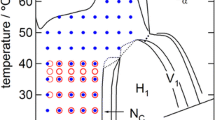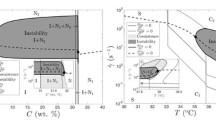Abstract:
We have investigated the simple shear flow behavior of wormlike micelles using small-angle neutron scattering and mechanical measurements. Ternary surfactant solutions made of cetylpyridinium chloride, hexanol and brine (0.2 M NaCl) and hereafter abbreviated as CPCl-Hex were studied in the concentrated regime, . In a preliminary report (Berret et al. [#!ref16!#]), the discontinuity of slope observed in the shear stress versus shear rate curve was interpreted in terms of first-order phase transition between an isotropic state and a shear-induced nematic state ( transition). At the transition rate, , the solution exhibits a macroscopic phase separation into viscous and fluid layers (inhomogeneous shear flow). Above a second characteristic shear rate, the flow becomes homogeneous again, the sheared solution being nematic only. The neutron patterns obtained in the two-state inhomogeneous region have been re-examined. Based on a consistent analysis of both orientational and translational degrees of freedom related to the wormlike micelles, we emphasize new features for the transition. In the present paper, the shear rate variations of the relative proportions of each phase in the two-state region, as well as the viscosity ratio between isotropic and nematic phases are derived. We demonstrate in addition that slightly above the transition rate, the shear induced nematic phase is already strongly oriented, with an order parameter P 2 = 0.65. The orientational state is that of a nematic flow-oriented monodomain. Finally, from the locations of the neutron scattering maxima for each isotropic and nematic contributions, we evaluate the concentrations for each phase and and derived a dynamical phase diagram of CPCl-Hex, in terms of the stress versus and . According to the classification by Schmitt et al. [#!ref22!#], the transition observed in CPCl-Hex micellar solutions could result from a positive flow-concentration coupling, in agreement with the observed monotonically increasing shear stress in the two-phase region.
Similar content being viewed by others
Author information
Authors and Affiliations
Additional information
Received: 16 February 1998 / Revised: 18 February 1998 / Accepted: 24 May 1998
Rights and permissions
About this article
Cite this article
Berret, JF., Roux, D. & Lindner, P. Structure and rheology of concentrated wormlike micelles [4]at the shear-induced isotropic-to-nematic transition. Eur. Phys. J. B 5, 67–77 (1998). https://doi.org/10.1007/s100510050420
Issue Date:
DOI: https://doi.org/10.1007/s100510050420




